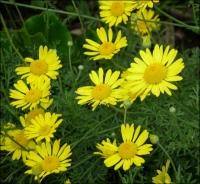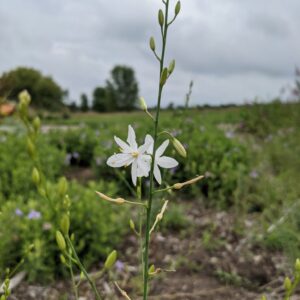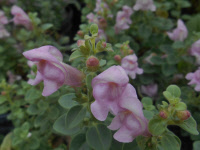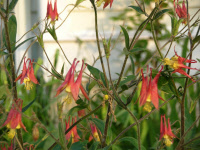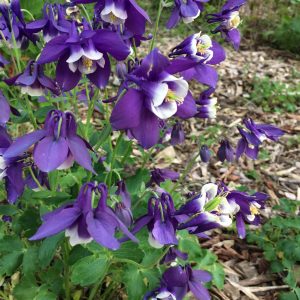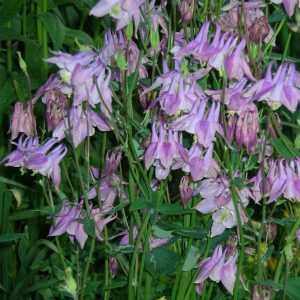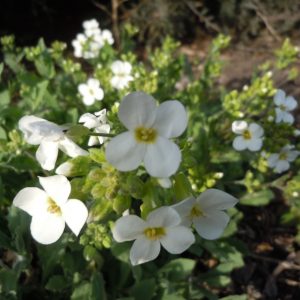Shop
Showing 65–72 of 778 results
-
Anthemis tinctoria Marguerite
Cheerful yellow daisies all summer, non-stop.
Cheerful yellow daisies all summer, non-stop.
Size: 2-3' x 2'
Care: Full sun well-drained to moist well-drained soil, drought tolerant
Native: Eastern EuropeThis promiscuous flower sports maize colored daisies with ferny, aromatic foliage. The name Anthemis evolved from anthemon meaning “free flowering,” which describes the plant’s carefree, June through fall, blossoms. Philip Miller illustrated Marguerite in his 1750’s Dictionary. The flower was used to dye wool and to make tea.
-
Anthericum ramosum Spider plant, Branched St Bernard’s-lily Z 5-8
White, branched flower clusters above grass-like leaves June-August
OUT OF STOCK – EMAIL FOR AVAILABILITY
White, branched flower clusters above grass-like leaves June-August
Size: 2-3’ x 12”
Care: full sun in well-drained soil
Native: Western, Central & Southern Europe
Wildlife Value: Attracts bees, butterflies and hummingbirdsPublished by Linneaus in Species Plantarum (1753)
-
Anthyllis vulneraria v. coccinea Red Kidney vetch, Woundwart Z 5-9
Foliage - low mound of downy silvery-green leaves, topped by ball-shaped red flowers May to July – showy, long-blooming makes wonderful groundcover or rock garden plant
ARCHIVED
Note: This is a plant not currently for sale. This is an archive page preserved for informational use.
Foliage – low mound of downy silvery-green leaves, topped by ball-shaped red flowers May to July – showy, long-blooming
Size: 4-6” x 12-18”
Care: sun in well-drained soil
Native: Europe
Wildlife Value: sole food plant for small blue butterfly caterpillars. Flowers provide nectar and pollen for beetles and bees.
Size: Showy, long-blooming makes wonderful groundcover or rock garden plantIn traditional medicine used externally to promote wound healing and internally as a laxative and for kidney disorders. Species is ancient written about by Greek Dioscordes. Red variety since at least 1753.
-
Antirrhinum hispanicum ‘Roseum’ syn. A. glutinosum Perennial snapdragon, Spanish snapdragon Z 5-8
Rose pink, with yellow above the lower lip, snapdragon-shaped blooms in spring, repeats in fall. Fuzzy, silver-grey foliage
ARCHIVED
Note: This is a plant not currently for sale. This is an archive page preserved for informational use.
Rose pink, with yellow above the lower lip, snapdragon-shaped blooms in spring and repeats in fall. Fuzzy, glaucous, silver-grey foliage. Excellent for places you want low-growing, drought tolerant flowers.
Size: 12” x 2’
Care: sun in well-drained soil
Native: Spain & Morocco
Wildlife Value: deer resistant, attracts hummingbirdsDescribed in 1852 in Pugillus Plantarum Novarum Africae Borealis Hispaniaeque Australis
-
Aquilegia canadensis Canada Columbine Z 3-9
May - June scarlet and yellow columbines
May – June, scarlet and yellow columbines
Size: 24-36”x 12”
Care: part shade in moist well-drained soil
Native: Eastern Canada to Florida, west to New Mexico, Wisconsin native.
Wildlife Value: Rich, sugary nectar important food for ruby-throated hummingbirds. Buntings and finches eat the seeds. Sole food source for columbine duskywing caterpillar.Seeds are fragrant when crushed, used by Omaha, Ponca and Pawnee as perfume. Pawnee used the plant as a love charm by rubbing pulverized seeds in palm of hand and endeavoring to shake hand of desired person. Crushed seeds also used to cure fever and headaches. Cherokee made a tea for heart trouble. The Iroquois used the plant to cure poisoning and to detect people who were bewitched. Grown by Englishman Tradescant the Elder in 1632. He may have received it from France. Cultivated by Washington & Jefferson.
-
Aquilegia flabellata v. pumila syn. Aquilegia flabellata ‘Nana’, Aquilegia fauriei Dwarf Fan columbine Z 4-9
April-May lilac blooms of nodding lilac-blue to purple sepals with white petals on compact mound of blue-green foliage
OUT OF STOCK
April-May lilac blooms of nodding lilac-blue to purple sepals with white petals on compact mound of blue-green foliage
Size: 6-9” x 9-12”
Care: sun to part shade in moist well-drained soil, Deadhead for rebloom
Native: Japan
Wildlife Value: deer and rabbit resistant. Attracts butterfliesLatin word flabellatus mean fanlike referring to leaflet shape. First published as Aquilegia buergeriana var. pumila in Swiss journal Bulletin de l’Herbier Boissier 5: 1090. 1897.
-
Aquilegia vulgaris Columbine, Granny’s bonnet Z 3-10
May to June purple, blue, red, pink or white cluster of dangling, bell-shaped petals flaring at the ends, held aloft by upright, arching stems.
May to June purple, blue, red, pink or white cluster of dangling, bell-shaped petals flaring at the ends, held aloft by upright, arching stems
Size: 36”x 18”
Care: Sun or part shade fertile moist well-drained soil
Native: EuropeVery ancient plant. Used medicinally in Middle Ages to cure pestilence, measles, small pox and jaundice and remove obstructions of the liver but large doses are poisonous. Aquilegia was mentioned in the literature of Chaucer and Shakespeare. It was a popular Elizabethan (Elizabeth I in the late 1500’s) cottage garden flower. French botanist Tournefort reported that women used the seeds to “drive out the Measles and Small Pox.” John Winthrop introduced this plant to the New World in the 1630’s. White form by 1600’s. Cultivated in America since 1700’s.
Double form: Aquilegia vulgaris var. plena Grown at America’s 1st botanic garden, Elgin Botanic Garden 1811. Described by L.H. Bailey as of garden origin with “flowers much doubled, ranging from white to deep blue.” (1933)
-
Arabis caucasica syn. A. alpina subsp. caucasica Alpine Rock Cress (Bastard Tower Mustard, Miller 1768) Z 4-9
Late spring white four-petaled racemes. Perfect for a dry border or rock garden. Drought tolerant.
OUT OF STOCK
Late spring white four-petaled racemes. Perfect for a dry border or rock garden. Drought tolerant.
Size: 6-12”x 20” spreads
Care: Full sun well-drained soil, vigorous; cut back after flowering to make it full.
Native: Southern Europe and Mediterranean.
Size: Perfect for a dry border or rock garden. Drought tolerant.Arabis is Greek for Arabian. Cultivated in the U.S. since 1800’s.

